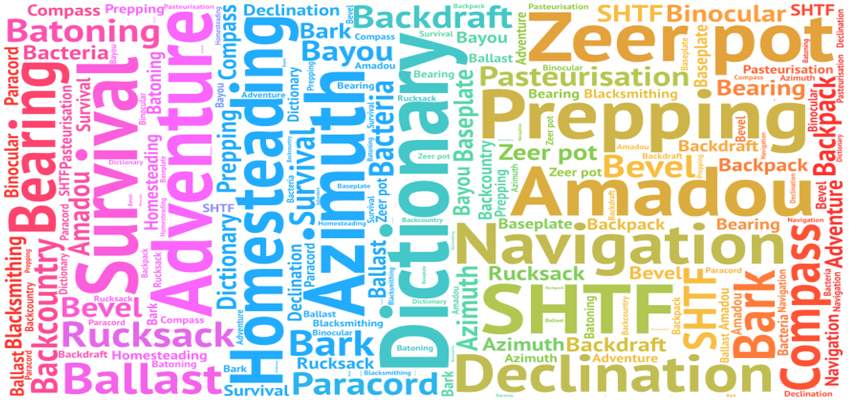
There are currently 20 names in this directory beginning with the letter #.
16-wind Compass Rose
Eight half-winds are obtained by bisecting the angles between the principal winds. The half-winds are north-northeast (NNE), east-northeast (ENE), east-southeast (ESE), south-southeast (SSE), south-southwest (SSW), west-southwest (WSW), west-northwest (WNW) and north-northwest (NNW). The eight principal winds and the eight half-winds together yield a 16-wind compass rose, with each compass point at a 221⁄2° angle from the next.
2-6-10
Abbreviation of “It’s gonna take 2 surgeons 6 hours to remove 10 inches of my boot from your ass”.
2182 kHz
This radio frequency is one of the international calling and distress frequencies for maritime radiocommunication in a frequency band allocated to the mobile service on primary basis, exclusively for distress and calling operations. It is analogous to channel 16 on the marine VHF band, but unlike VHF which is limited to ranges of about 20 to 50 nautical miles depending on antenna height, communications on 2182 kHz and nearby frequencies have a reliable range of around 50 to 100 nautical miles during the day and 150 to 300 nautical miles or sometimes more at night.
2x4
Or two-by-four, it is a reference to a piece of wood with cross-section measuring two inches by four inches and one and a half inches by three and a half inches when finished.
32-wind Compass Rose
The sixteen quarter winds are the direction points obtained by bisecting the angles between the points on a 16-wind compass rose. The sixteen quarter-winds are north by east (NbE), northeast by north (NEbN), northeast by east (NEbE), east by north (EbN) in the first quadrant, east by south (EbS), southeast by east (SEbE), southeast by south (SEbS), south by east (SbE) in the second quadrant, south by west (SbW), southwest by south (SWbS), southwest by west (SWbW), west by south (WbS) in the third quadrant, and finally west by north (WbN), northwest by west (NWbW), northwest by north (NWbN) and north by west (NbW) in the fourth quadrant.
4 Wheel Drive
A transmission system providing power directly to all wheels of a twin-axled vehicle, typically designed for off-road driving. Also called four-by-four or 4WD.
50-90 Rule
Used for navigating during and in tidal streams where the maximum speed to the tidal is stream is known. The 50-90 Rule states that the speed of the tide is 50% of the maximum speed in the first hour after slack water, increasing to 90% in the second hour and 100% in the third hour before reducing to 90% and 50% in the fourth and fifth hours respectively. At the end of the sixth hour the tidal stream reduces to zero before the cycle starts again.
500 kHz
This has been an international calling and distress frequency for Morse code maritime communication since early in the 20th century. Many SOS calls and medical emergencies at sea were handled here until December 1999. However, because of the near disappearance of the commercial use of Morse code, the frequency is now rarely used. Emergency traffic on 500 kHz has been almost completely replaced by the Global Maritime Distress Safety System (GMDSS). Beginning in the late 1990s, most nations ended monitoring of transmissions on 500 kHz. The nearby frequencies of 518 kHz and 490 kHz are used for the Navtex component of GMDSS.
8000ers
The 14 mountains that are more than 8,000 metres high. All eight-thousanders are located in the Himalayan and Karakoram ranges. They are Everest (8848 m, Nepal, China), K2 (8611 m, Pakistan, China), Kangchenjunga (8586 m, Nepal, India), Lhotse (8516 m, Nepal, China), Makalu (8485 m, Nepal, China), Cho Oyu (8201 m, Nepal, China), Dhaulagiri I (8167 m, Nepal), Manaslu (8163 m, Nepal), Nanga Parbat (8126 m, Pakistan), Annapurna I (8091 m, Nepal), Gasherbrum I (8080 m, Pakistan, China), Broad Peak (8051 m, Pakistan, China), Gasherbrum II (8035 m, Pakistan, China) and Shishapangma (8027 m, China).
9-Volt Battery
Constructed of six 1.5V LR61 batteries, enclosed in a wrapper, in a rectangular shape, with rounded edges and a polarised snap connector at the top.
Click the thumbnail below and buy the digital edition of the Dictionary:
If there is a word or phrase or term or acronym that you want included in the SURVIVAL DICTIONARY, fill out the form below and mail it to us.




wilderness survival kit canada
The term “survival kit” may also refer to the larger, transportable survival kits ready by survivalists , known as “bug-out bags” (BOBs), “Individual Emergency Relocation Kits” (PERKs) or “get out of Dodge” (Good) kits, which are packed into backpacks, or even duffel bags. These kits are developed especially to be more simply carried by the person in case alternate forms of transportation are unavailable or impossible to use.